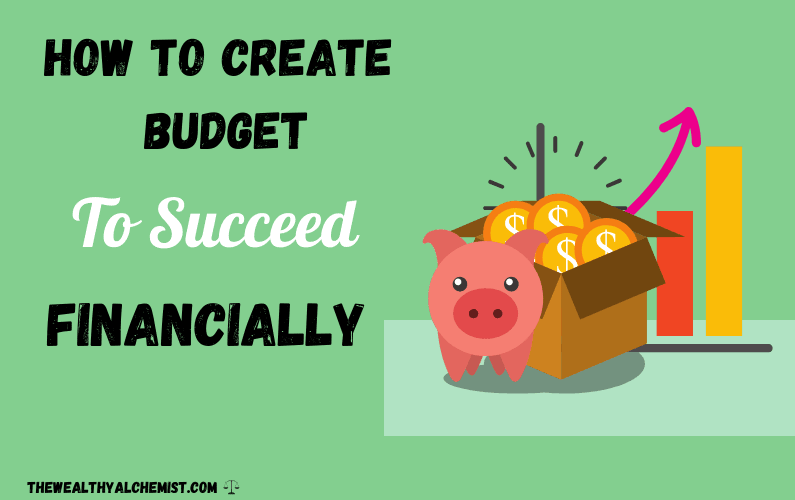
Knowing how to create a budget is one of the most important and most basic steps when getting your finances together.
Not just because it helps you track your cash flow, but also because it helps you create a plan for your money and ensure your long-term financial success.
However, many people consider budgeting a daunting task and become overwhelmed by just the thought of keeping track of all those numbers. This keeps them from ever starting a budget.
While others may have dabbled in budgeting now and again but found that it didn’t work out for them. Either due to lack of discipline or consistency.
Still, others may think that budgeting is not a necessary tool in their lives, so they were never interested in giving it a shot.
With that being said, if you’re intimidated by the numbers, or you tried and failed to stick to a budget, or just don’t think you need it then I’d ask you to reconsider.
Because the truth is, if you have any money troubles at all, then you need a budget.
It’s one of the most powerful tools out there to help you get your money under control. And that’s exactly what I want to show you in this post.
After learning how to create a budget you’ll:
- Know how to better allocate your money towards the things that are important to you.
- Know exactly where your money is going and where you’re losing it.
- Have insight into your spending habits and where your money priorities are.
- Create a real clear picture of your financial situation.
- Have a road map to end paycheck to paycheck living.
- Be better able to live within your means, knowing what you can afford now and what you can’t.
Related post: Complete Guide to Sinking Funds Categories.
Personally speaking, we can’t tell you enough how creating a budget has helped us to get our finances under control. It’s helped us stay on track and start working towards the things we truly believe are important for us.
And this why we also created our course how to stop paycheck to paycheck living that you can access here.
At the beginning of our marriage we were living with one salary, so managing our finances became a priority every month. And budgeting taught us how to be more mindful with our money and plan our spending based on the needs we had instead of just the wants.
We have created this article to share with you how to create a budget that is easy to follow, so you too can also start getting your money under control.
How to create a budget
Step 1: Calculate your monthly income
The first step learning how to create a budget is to determine how much money you’ll get every month. This should include the money you’ll receive from every income stream you have.
If you live by yourself, it’s easy, but if there are other members of the family that you share income with, make sure to include their income as well.
Also, remember to only include your net income and not the gross amount! This will be easy if your income is from a 9 to 5 job, because your taxes and other deductions will already be taken out.
But if you’re a contractor or a freelancer, the check you get isn’t 100% yours. You’ll eventually have to send a chunk to Uncle Sam, so make sure you don’t include your tax money in your budget.
Adding up your total income example
- Monthly net income from 9 to 5: $3,500
- Side Hustle: $850
- Freelance income: $350
Total expected income: $4,700
| Important Things to Remember |
| 1. Consider how many times you get paid, bi-weekly, or monthly. |
| 2. If any of your icome (wheter from your main job or a side hustle) is irrgular, make a projection based on the lowest amount you have received in the last twelve months. |
| 3.Don’t include any bonuses in your budget, unless you are totally sure, you will receive it. |
| 4. Create the budget before the money arrives into your bank account. |
| 5.Consider any fluctuations your income can have, including commissions and overtime. |
Step 2: Add up your monthly expenses
In this step, you basically list out all of your expenses and add them up.
Here you should consider two groups of expenses. Fixed (or essential) expenses and variable (or discretionary) expenses.
Fixed expenses: Are expenses that generally don’t vary in amount from month to month.
These bills are required, stable, and are paid on a regular basis. For example, rent payments, insurance, and car payments are all fixed expenses.
Variable expenses: Are expenses that we can consider non-essential. They may also change from month to month and maybe a bit unpredictable.
Because even if you make a projection for these costs, they may not be exact. They include things such as clothing, holiday spending, entertainment, etc.
Estimating your variable expenses as accurately as you can make the difference in how well you stick to your budget. Because, believe it or not, these are usually the ones that end up breaking our budgets.
If you’ve never estimated your variable expenses before you can start by creating a simple list of expenses based on your spending history. After that, you can lump your usual expenses into categories.
Below we have put together some sample expense categories:
Pro tip: If you have a hard time estimating your variable expenses you should consider signing up for free apps such as Personal Capital. When you sign up with Personal Capital you can link your bank account and see exactly what you spent your money on. They also categorize your spending for you!
Budget categories
Housing: Rent, Mortgage, insurance payments, property taxes.
Utilities: Electricity, gas, heating oil, water, sewage.
Healthcare: Monthly prescriptions and insurance premium.
Transportation: Monthly car note, gasoline, insurance, annual registration and commuting cost like, subways, fares, tolls, train tickets, if applicable.
Education: Any payment for yourself or any other family member. Things such as student loans, tuition, kids school, lunch programs.
Food cost: In this category, include grocery cost, not restaurants because they are discretionary. Grocery prices can change from week to week, so you should estimate on your grocery spending habits. Grocery should be considering a fix cost.
TV cost: This includes cable, Netflix, Vudu, Hulu or other TV services you use
Cell phone – If you’re paying too much for cell phone service, then you definitely want to sign up for Mint Mobile. Only $15 a month!
Internet services
Entertainment: This includes any fun activity you do, movies, parks, attraction, visiting museums, holidays, restaurants.
Clothing: This include how much money you spend buying clothes to work, events or in general.
Charity and donation: If you usually donate or give money regularly, you should include this in your budget.
Saving fund: This includes money that you have put into saving for things like travelling, retirement or another project you have in mind.
Miscellaneous expenses: Birthdays, anniversaries, gifts, Christmas decorations, childcare, magazines subscriptions.
| Important Things to Remember |
| 1. Make sure you go through the annual expenses that you have, so you don’t forget the ones that dont appear every month. Review your bank statements if there’s something you don’t remember. |
| 2. Talk about your budget with your spouse, or other family members in your house that are under the same budget, so you won;t have any extra surprise. |
| 3. Determine your fixed expenses and create a list and write them on your budget under this category. |
| 4. Make sure you keep track of your variable expenses and make a projection for your budget based on tyour spending history. Consider seasonal spending like, summer activities with your kids, gifts for christmas etc. |
| 5. Use a tool that help you keep track of your spending and make projections. Personal Capital is a FREE financial tool that makes this task easier for you. You can give it a try and sign up for personal capital here. |
Step 3 – Subtract your expenses from your income
Once you have added up your total expenses (fixed and variable) simply subtract them from your total income.
This step is where some of us may need to make an adjustment based on the result we get.
A negative balance means that you have a deficit in your budget. In this case, you should go back and check out some of the expenses you have and try to reduce them based on your priorities.
We can tell you based on our experience that when we had a negative result in our budget, it was usually related to variable expenses and not the fixed ones.
It was sometimes because we planned on eating out more than we could afford to. Or because we over-budgeted for something unessential. When this happened, we had to adjust our expenses.
If you find that your expenses exceed your income then you may have to do the same.
If correcting your variable expenses is not enough to fix your budget, you may have to start searching for ways to increase your income.
Pro tip: To earn some extra money, you can start by taking some surveys online to generate extra cash. Check out these surveys to start making some extra money today!
A positive balance means that you’re earning more money than you plan on spending.
That’s great, because you can make plans with this extra money. Whether it’s towards creating an emergency fund, investing for retirement, or paying off debt.
If you’re looking to get your feet wet in the stock market right now then I’d recommend you sign up with Acorns. This app will round your purchases up to the nearest dollar and invest your would-be pocket change!
Setting up your financials goals
When you create financial goals, you are ensuring that you will be working towards things that are valuable for you and your financial future.
Whether you’re trying to pay off debt save up money, invest, or something completely different, budgeting can help you achieve it.
Besides your budget, here are some resources that may help you achieve your financial goals.
- Empower – for budgeting
- Digit – for saving
- Acorns – for investing
- Personal capital – for budgeting and expense tracking
Essential tips to succeed with your budget
- Remember to monitor your budget. You must be on top of it and monitoring is one of the most essential steps to assure yourself that you are in the right path.
- Adjust and be flexible: Budgeting is not a static task, you should make adjustments based on problems you detect. If there is something that does not work, try something new until you get the result you want.
- Set a day to check on your budget. If there are other family member involved, make sure you include them too.
- Be realistic when creating your budget. Underestimating your expenses won’t help, instead will mess up your budget.
How to Create a Budget – Final Thoughts
Budgeting is about more than just numbers, it’s about creating a plan for your financial future.
If you’ve never created a budget before, we hope you have a pretty clear idea of how to start after reading this post.
Cheers!

Idalmis
Latest posts by Idalmis (see all)
- Why Is Budgeting Important? 12 Best Reasons to Start Budgeting Today! - October 6, 2020
- How to be Frugal With Groceries. Must Try Tips! - September 15, 2020
- Is Skillshare Worth It? Best 2020 Review - August 31, 2020

